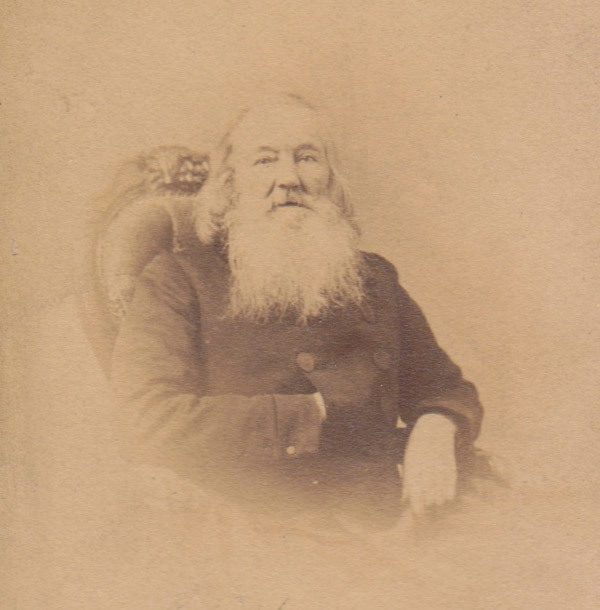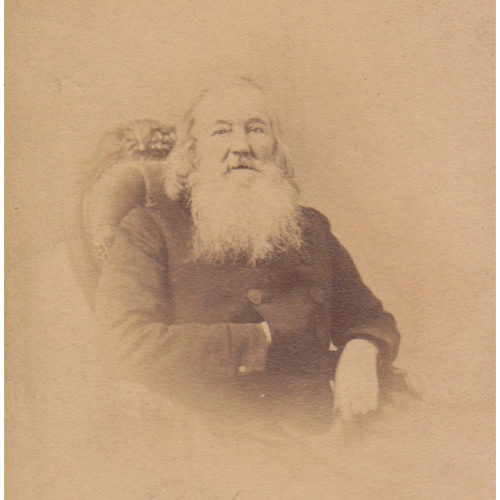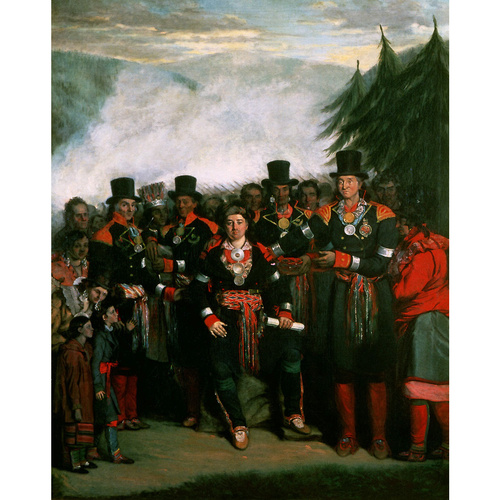
Source: Courtesy of Wikimedia Commons
THIELCKE, HENRY DANIEL, painter, engraver, and teacher; b. 20 Oct. 1788 in the parish of St Martin-in-the-Fields, London, son of Johan Daniel Friederich Thielcke and Ann Elizabeth Paschal; m. 2 Feb. 1820 Rebecca Piercy (Percy) (d. 10 March 1885) in Buckingham, England, and they had four boys and four girls; d. 25 Nov. 1874 in Chicago and was buried there two days later.
The German-born parents of Henry Daniel Thielcke worked at the Queen’s House (known as Buckingham Palace from the 19th century) in London. His mother was a servant of Queen Charlotte. His father, a valet to King George III, had previously been in the employ of the East India Company.
On 4 Jan. 1806 Thielcke began his training at the Royal Academy Schools in London and studied there until at least 1807, the year the institution awarded him a silver medal for his drawing of the Farnese Hercules. His style showed the influence of the English painters Sir Joshua Reynolds and Thomas Lawrence. He lived for a time in the Queen’s House and then around the mid 1810s settled in the Covent Garden area.
Between 1805 and 1816 Thielcke’s works were occasionally included in exhibitions of the Royal Academy of Arts and the British Institution. He depicted religious themes (Madonna and Child, 1809; A Holy Family, 1811; The adulterous woman delivered, 1813) and mythological subjects (Atlas, 1807; Priam supplicating Achilles for the body of Hector, 1815; Cupid wounding Venus, with love for Adonis, 1816). He also executed several portraits of the royal family and members of the court, including paintings of William Kuper, almoner to King George III (The Rev. Mr. Küper, chaplain to His Majesty, 1807), and Princess Charlotte Augusta (H.R.H. The Princess Charlotte Augusta of Wales, 1818). He made stipple engravings of the portraits of the Prince Regent, the future King George IV (Georgius. Princeps. Wallae. Patriam. Pro-Patre. Regens, 1814), Queen Charlotte (Her Most Gracious Majesty, 1818), and King George III (His Most Gracious Majesty, 1819); he signed the last “H. D. Thielcke, portrait painter of H.R.H. the Duchess of York.”
In 1820 the deaths of his patron, the Duchess of York, and King George III seemed to put an end to Thielcke’s artistic activity in England, where it is estimated he produced 36 works. For reasons that are unclear, he apparently did not resume creative work until 1832, apart from painting a portrait of his father in about 1826. Yet after 1820 he stayed for a few more years with his family in London, where two of his children were baptized (Augustus Frederick in 1822 and Frederica Mary in 1824).
From the second half of the 1820s until the early 1830s, Thielcke lived with his wife and children in Edinburgh, where two daughters, Mary Elizabeth and Elizabeth, were born in 1826 and 1828 respectively. Their second son, George Benjamin, was born in 1832 in Duddingston (Edinburgh). According to The Edinburgh almanack, or universal Scots and imperial register, … (published in that city), Thielcke worked as a clerk at the Board of Excise (1827–29) and belonged to the Knights Templar (1831–33). His motives for leaving Scotland are unknown.
Thielcke arrived in Quebec City with his family in 1832. That autumn he advertised his services in local newspapers, including the Quebec Mercury, where on 13 November he introduced himself as follows: “M. H. D. Thielcke, portrait painter to Her Royal Highness the late Duchess of York, will resume the exercise of his profession of artist and paint portraits in oils and miniatures.” He may have believed that his relationships with members of the royal family and the court made him the best-trained painter in the area. His known achievements in Lower Canada comprise about 20 works.
In 1833 Thielcke had a studio at the Château Saint-Louis, the residence of the governor-in-chief, Lord Aylmer [Whitworth-Aylmer*]. Following the 1834 fire at the château, he acquired through the kindness of Louis-Joseph Papineau*, head of the Patriote party and speaker of the Legislative Assembly of Lower Canada, the use of larger premises in the legislative building. At that time it was on the site that would be known from the beginning of the 20th century as Montmorency Park. There he painted a canvas representing the baptism of Christ. Exhibited in his studio the following year, this work initially received a positive review in the locally published Le Canadien on 19 August. It was followed by a second, devastating appraisal that appeared in the same paper on 2 September and was signed “Des Amateurs.” The art historian Gérard Morisset* attributed it to the painter Antoine Plamondon*. On 26 Sept. 1838, again in Le Canadien, Thielcke challenged Plamondon, whom he did not fear as a competitor, to “produce an original ‘Painting of History, and a Landscape from life’ for the next contest for prize medals, sponsored by the Literary and Historical Society. [The result] will decide who between us is the best Artist.” Plamondon declined the invitation, and on 20 April the following year Thielcke won a first-class silver medal for his depiction of James Wolfe* landing ashore.
In May 1838 Thielcke left the legislative building and settled on Rue Saint-Georges (Côte d’Abraham). In September he opened the Academy of Painting and Drawing at the Galerie de Peinture de Québec, an art museum established that June by the painter Joseph Légaré* and the lawyer Thomas Amiot. Thielcke gave modestly priced classes there for men and women two days a week.
Thielcke painted numerous portraits, such as those of an unidentified woman (Elegant young woman, 1834), surgeon Henry Grasett (Portrait of Henry W Grasett M.D., 1835), the new governor-in-chief, the Earl of Gosford [Acheson*] (Archibald Acheson, 2e comte de Gosford, 1836), physician Thomas Fargues* (Docteur Thomas Fargues, 1843), Coseigneur de Lavaltrie Gaspard de Lanaudière (Portrait de Charles-Barthélémy-Gaspard Tarieu de Lanaudière, c. 1853), and physician Joseph Morrin* (Docteur Joseph Morin, 1854).
His portrait of Maria Jones (Mrs. William Burns Lindsay and her son John, 1836), wife of William Burns Lindsay, clerk of Lower Canada’s Legislative Assembly, was a success despite some drafting issues, the treatment of the drapery, and the anatomical rendering. The art historian Mario Béland is of the opinion that “through its spirited workmanship and intimist design in the tradition instituted by [Sir Joshua] Reynolds, [this] portrait … can be seen as a unique work among the productions of the period, distinguishable, for example, from the portraits of the same kind by Hamel [Théophile Hamel*], [which were] inspired more by the aesthetic principles of classicism.”
In 1840 Thielcke completed a group portrait, The presentation of a newly-elected chief of the Huron tribe, Canada. The painting commemorates the February 1838 reception, at Jeune-Lorette (Wendake), of Quebec City’s deputy chief of police and justice of the peace, Robert Symes, as honorary chief of the “council of the Huron tribe” (Huron-Wendat nation council). The ceremony was held to acknowledge his contribution to ending the 1834 cholera epidemic. It is the artist’s best-known work, in part by virtue of its vibrant colours, and his most ambitious. Symes is surrounded by some 15 figures, prominent citizens of Quebec City and eminent members of the Huron (Huron-Wendat) nation, such as Chief Zacharie Vincent*, who is the only one in traditional Indigenous dress. The others are wearing European-style clothes and some have arrow sashes. Over the years the production of numerous lithographic prints of the painting, particularly in London, contributed to the renown of the artist and his work. It was displayed at the 1853 universal exhibition in New York City and at the Quebec provincial exhibition, where it was awarded first prize.
At the end of 1841 Thielcke went to New York, where he painted portraits of some of its residents. He exhibited four at the National Academy of Design in 1842 (all were pre-sold except the Portrait of Master Joseph B. Livingston), as well as a landscape, Early morning. He executed at least nine works in New York, including Henry Evelyn Pierrepont (1808–88) and a copy of the portrait of politician John Watts by Henry Inman.
Back in Quebec City in 1842, Thielcke announced on 8 October in the Quebec Mercury that henceforth his new studio would be located at 8 Rue Haldimand. In the autumn of 1844 he began to teach French – it is not known, however, how he learned the language – and drawing at the Quebec High School. In 1852 he would leave his position because of the low salary and his desire to once more take up portraiture. In the Quebec Mercury of 12 October, he publicized his work as a painter and declared that he would resume his drawing classes (this time for young men only); he also offered private German, French, and drawing lessons. He resided at 24 Rue Saint-Louis.
Beginning in 1854 Thielcke helped to administer the Church Society of the Anglican Diocese of Quebec, to which he had contributed financially since 1850. He accepted the post of assistant secretary of the Literary and Historical Society of Quebec in early 1851. At the beginning of the following year he was elected committee secretary and held the position of recording secretary in 1853. The society, which was housed in the legislative building, suffered the consequences of a fire that destroyed the structure, including the contents of Thielcke’s secretarial office, on 1 Feb. 1854 [see Pierre Chasseur*]. He was dismissed from his position in the summer and left Lower Canada in September. Plagued by financial difficulties, he had sold all his furniture; notes concerning the portrait he painted of Morrin that year imply that the artist was short of basic necessities. In 1856 a legal proceeding, the nature of which is unclear, pitted him against the Literary and Historical Society.
Thielcke and his family then settled in Chicago. On 25 Oct. 1854, less than a month after his arrival, the painter advertised his services: painting and drawing lessons and, three days a week, portraiture. Aside from a picture of Sarah Woodruff Davis (Sarah Walker Davis, 1856), the wife of an Illinois notable, and a self-portrait with his wife (Portrait of the artist and his wife, 1857), few of Thielcke’s works remain from this period in the United States. According to his family, Chicago’s great fire of 1871 destroyed almost everything he had created. The artist died there in 1874, virtually unknown.
Henry Daniel Thielcke painted notable figures from England, Lower Canada, and the northeastern United States. As of the early 21st century, about 80 of his works have been inventoried. Major Canadian and British museums exhibit some, and the British royal collection holds about ten. The unevenness of his artistic production – a number of portraits are of poor quality – appears to be his major failing. His reputation rests mainly on The presentation of a newly-elected chief of the Huron tribe, Canada, which demonstrates his technical competence and ensures his renown.
Patrick White in collaboration with David Karel and Annie Fraser
This biography is based on the author’s work Henry Daniel Thielcke: la vie d’un peintre royal méconnu, written in collaboration with David Karel and Annie Fraser ([Québec], 2022). It contains a list of documents that were consulted by the author.
Ancestry.com, “Cook County, Illinois, U.S., marriage and death indexes, 1833–1899,” 27 Nov. 1874, 12 March 1885: www.ancestry.ca/search/collections/2433; “Westminster, London, England, Church of England baptisms, marriages and burials, 1558–1812,” St Martin-in-the-Fields (London), 16 Nov. 1788: www.ancestry.ca/search/collections/61865; “England & Wales, national probate calendar (index of wills and administrations), 1858–1995,” 15 June 1875: www.ancestry.ca/search/collections/1904; “London, England, Church of England marriages and banns, 1754–1938,” St Alban, Wood Street (City of London), 31 Jan. 1782: www.ancestry.ca/search/collections/1623; “London, England, Church of England births and baptisms, 1813–1923,” All Hallows, Barking by the Tower (City of London), 27 March 1822: www.ancestry.ca/search/collections/1558; “London, England, Church of England births and baptisms, 1813–1923,” St George, Hanover Square (Westminster), 12 Aug. 1824: www.ancestry.ca/search/collections/1558; “England, select marriages, 1538–1973,” Hitcham, Buckingham, England, 2 Feb. 1820: www.ancestry.ca/search/collections/9852; “Scotland, select births and baptisms, 1564–1950,” Duddingston, Midlothian, Scot., 8 June 1832: www.ancestry.ca/search/collections/60143; “Scotland, select births and baptisms, 1564–1950,” Saint Cuthberts, Edinburgh, Midlothian, Scot., 12 Jan. 1827, 11 May 1828: www.ancestry.ca/search/collections/60143 (all links consulted 14 Feb. 2022). Bibliothèque et Arch. Nationales du Québec, Centre d’arch. de Québec, CE301-S61, 21 juin 1836, 16 juill. 1838. Mario Béland, “De Berczy à Krieghoff: peintres étrangers au Bas-Canada, 1790–1850,” Vie des arts (Montréal), no.49 (hiver 1992–93): 10–17.
Cite This Article
Patrick White in collaboration with David Karel and Annie Fraser, “THIELCKE, HENRY DANIEL,” in Dictionary of Canadian Biography, vol. 10, University of Toronto/Université Laval, 2003–, accessed December 12, 2025, https://www.biographi.ca/en/bio/thielcke_henry_daniel_10E.html.
The citation above shows the format for footnotes and endnotes according to the Chicago manual of style (16th edition). Information to be used in other citation formats:
| Permalink: | https://www.biographi.ca/en/bio/thielcke_henry_daniel_10E.html |
| Author of Article: | Patrick White in collaboration with David Karel and Annie Fraser |
| Title of Article: | THIELCKE, HENRY DANIEL |
| Publication Name: | Dictionary of Canadian Biography, vol. 10 |
| Publisher: | University of Toronto/Université Laval |
| Year of publication: | 2023 |
| Year of revision: | 2023 |
| Access Date: | December 12, 2025 |




